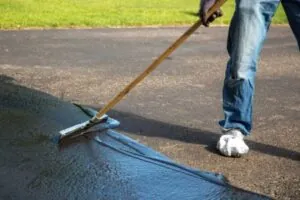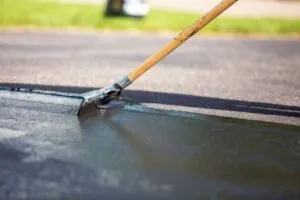Repair and sealing are key to maintaining your driveway’s look and integrity. When filling cracks in an asphalt driveway, the right driveway patch and sealer are essential. After the patch has been set, driveway patching and sealing can be done to ensure long-term durability.
This guide explains the driveway patch and seal application process, offering step-by-step instructions for optimal results. You will learn how to properly clean the surface, apply the patch, and sealcoat for maximum protection. Regular maintenance, including sealing every few years, helps prevent further damage from weather, water, and heavy traffic.
Understanding Driveway Repair and Sealing
Asphalt repair and sealing are essential for maintaining the longevity and appearance of your driveway. Over time, weather and wear can cause cracks and damage. Driveway patch and seal services help prevent further deterioration. Proper sealing protects the surface from water, oil, and other harmful elements, ensuring durability.
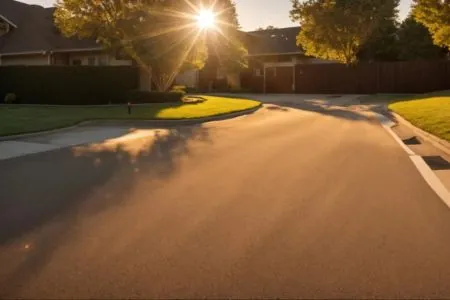
What is Driveway Patching?
Patching involves repairing cracks, holes, and other damage in an asphalt driveway. The damaged areas are filled and blended with the surrounding surface using a specialized driveway patch and sealer. This process prevents further deterioration by restoring the structure. Patching and sealing application is vital to stop the damage from spreading and ensure your driveway remains functional. Filling cracks in asphalt driveways promptly reduces the need for extensive repairs in the future and helps maintain its longevity and appearance.
What is Driveway Sealing?
Driveway sealing is the process of applying a protective coat over the entire driveway to safeguard it from external elements. This sealer creates a barrier against water, oil, and other substances that can damage the asphalt. A patch and sealer application protect both patched areas and unsealed sections. Regular repair and sealing help preserve the surface’s integrity, prevent further cracking, and enhance curb appeal. Sealing your driveway extends its life by providing a durable protective layer against wear and tear.
Can You Seal Over a Driveway Patch?
Yes, you can seal over a driveway patch, but waiting for the patched area to fully cure is important before applying the sealer. Sealing too soon can result in ineffective protection and may interfere with the patch’s ability to bond properly to the asphalt. The patching material must have sufficient time to set, ensuring it is fully integrated into the surface before adding the sealing layer. Once the patch is cured, applying the right driveway patch and sealer can help protect the repair and improve the overall durability.
Related Post: Sealing Cracks in Asphalt Driveway: Types and Maintenance
Steps to Properly Seal Over a Driveway Patch
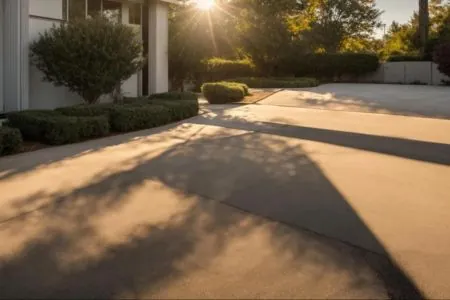
When patching and sealing are done, ensure the patch has cured completely. Clean the area of debris and dirt. Then, apply a driveway patch and sealer evenly across the patched section. Ensure cracks are filled thoroughly in the asphalt driveway, smoothing the surface for optimal coverage.
Step 1: Cleaning the Driveway
Cleaning the driveway is a crucial first step before sealing. Sweep or power wash the surface to remove dirt, leaves, and debris. This ensures the driveway patch and sealer bond properly. It is also essential to clear cracks and holes and remove any old patching material. Cleaning these areas helps the sealer adhere effectively, creating a smooth and lasting finish. A clean surface ensures the driveway patch and seal will work as intended, providing better protection and improving the overall appearance of your driveway.
Step 2: Letting the Patch Cure
Letting the patch cure is an essential step before applying any sealer. After filling cracks and holes, allow the patch to set and harden fully. Curing times can vary depending on the materials used, but rushing this step can result in an ineffective seal. Ensure the driveway patch and sealer are applied only after the patch is excellent and stable. An adequately cured patch will bond more effectively with the sealer, ensuring better durability and preventing future damage.
Step 3: Applying the Sealant
Once the patch has cured, it is time to apply the sealer. For the best results, choose a driveway patch and sealer that match your asphalt type. Apply the sealer evenly over the entire surface, covering both patched areas and unsealed sections. This process protects the driveway from further damage and enhances its overall appearance. The sealer provides a barrier against water, oil, and other harmful substances, ensuring a longer-lasting driveway. Proper driveway patching and sealing improves both functionality and curb appeal.
Benefits of Driveway Patching and Sealing
Driveway patching and sealing offer numerous benefits, including preventing further damage from weather and traffic. Sealing over cracks and patches improves the driveway’s appearance and extends its lifespan. Regular driveway patch and seal applications protect against water penetration, oil stains, and freezing, keeping your driveway functional and attractive.
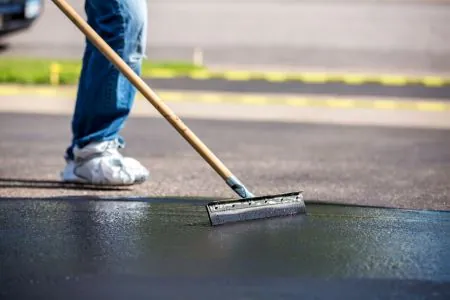
Improved Durability
Regular driveway repair and sealing help maintain the structural integrity of your driveway. Sealing provides a protective layer that prevents water, oil, and other harmful substances from penetrating the surface. This extends the life of your driveway and reduces the need for frequent repairs, saving you time and money in the long run.
Enhanced Appearance
A freshly sealed driveway enhances the overall look of your property. A properly sealed driveway’s dark, glossy finish improves curb appeal and makes the entire property appear well-maintained. Sealing over a driveway patch can also help make the repaired areas less noticeable, giving your driveway a smooth, consistent look.
Cost-Effective Maintenance
Investing in driveway patching and sealing is a cost-effective way to maintain your driveway. Regular maintenance can prevent costly repairs down the road. Sealing the driveway helps avoid extensive damage and is far less expensive than resurfacing or replacing the entire driveway. By filling cracks in asphalt driveway and applying a quality sealer, you are ensuring that your driveway stays in good condition without breaking the bank.
Increased Property Value
A well-maintained driveway can significantly boost your property’s curb appeal and overall value. Regular driveway patching and sealing ensures that the surface remains attractive, which is especially important if you plan to sell your home. Buyers tend to notice the driveway’s condition, and a smooth, sealed surface gives the impression of a well-maintained property. This simple driveway repair and sealing investment can increase your home’s resale value and attract more potential buyers.
Protection Against Oil and Stains
Driveway sealing protects against stains from oil, grease, and other substances. When driveway patching and sealing are done correctly, the surface is sealed to prevent these stains from absorbing, making cleaning easier. Oil stains can break down asphalt over time, causing long-term damage. A quality driveway patch and sealer prevent these substances from penetrating the surface, maintaining the driveway’s appearance and preventing structural damage that could lead to costly repairs or replacement.
Protect Your Driveway Today!
Protecting your driveway with regular repair and sealing is essential for maintaining its longevity and appearance. Driveway patching and sealing fill cracks and protect the surface from water, oil, and other damaging elements. Proper patch and sealer application ensure your driveway remains durable and visually appealing. If you notice cracks or damage, addressing them early with driveway patch and seal services to prevent further deterioration is essential.
Contact a professional for repair and sealcoating to get the best results. With regular maintenance, your driveway will stay safe, functional, and attractive for years, saving you time and money on costly repairs in the future. Call our team of experts today to get started on your own driveway sealing and coating project!
FAQs on Driveway Patch and Seal
How long does a driveway patch last?
A driveway patch’s lifespan depends on the material used and environmental factors. Cold patch asphalt is a temporary fix, typically lasting one to two seasons before requiring reapplication. Hot mix asphalt, when properly applied and sealed, can last several years. Regular maintenance, including sealing and prompt repairs, helps extend the longevity of the patch and prevents further damage.
Can you patch a cracked driveway?
Yes, you can patch a cracked driveway using cold or hot mix asphalt. Cold patch asphalt is easy to apply and allows for immediate use, making it a convenient short-term solution. Hot mix asphalt, on the other hand, provides a more durable and long-lasting repair. Before patching, it’s essential to clean the crack thoroughly to ensure proper adhesion and prevent further deterioration.
How long should you wait to seal a driveway after patching?
After patching a driveway, it is crucial to wait until the patch has fully cured before applying a sealant. The curing time varies depending on the patch material and weather conditions, typically ranging from a few days to several weeks. Sealing too soon can trap moisture, weaken the repair, and reduce its effectiveness. Always follow the manufacturer’s recommendations for the best results.

